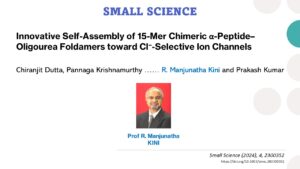
ABSTRACT
Constructing artificial ion channels is a challenging task. Herein, the de novo design of transmembrane ion channels made up of amphiphilic peptide–oligourea chimeric helices is described. They consist of an oligourea segment (7-mer) attached to the C-terminus of a short peptide (8-mer). Mass spectrometry (MS) and transmission electron microscopy (TEM) analyses show that in an aqueous solution, two of these chimeras (HPU-E and HPU-N) independently form defined oligomeric structures. TEM also shows that they form fiber bundles. The third related chimera HPU-F does not oligomerize (MS) but forms spherical nanostructures (TEM). HPU-E and HPU-N exhibit anion transport activity across lipid bilayers via antiport mechanism (HPU-N > HPU-E). The anion selectivity of HPU-N is Cl−>NO3− > Br−>SCN− > I− > AcO−>F−, which can be due to anion binding within the channels rather than size exclusion. Patch-clamp data support HPU-N’s Cl− selectivity (PCl−/PI− = 3.26). X-ray crystal structure (1.77 Å) of HPU-N reveals well-packed α-helices, and cryo-electron microscopy data shows the formation of nanotubes (13.7 Å diameter pores) and transmembrane channels. The study shows that α-peptide–oligourea-based de novo design can yield unique bioactive molecules with defined structures and functions.
Full article:https://doi.org/10.1002/smsc.202300352
